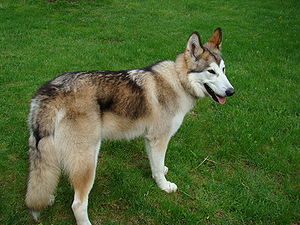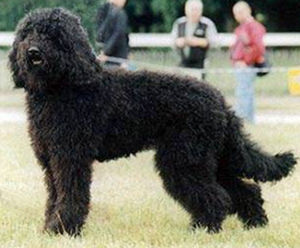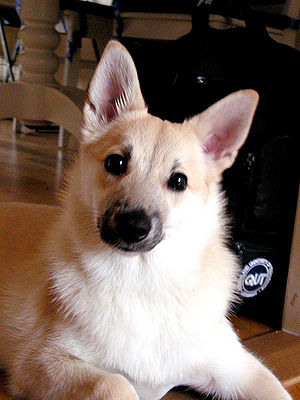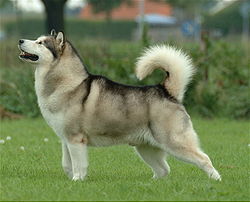 |
| Vital Statistics: |
| Place of Origin: United States |
| Group: Working dog, Companion dog |
| Height: 23-34 in. |
| Weight: 55-120 lbs. |
| Life span: can be up to 19 yrs. |
| Trainability: high |
| Good with children: yes |
| Good with other pets: yes |
What is the origin of the Native American Indian Dog?
The Native American Indian Dog was used for everything including pulling loads and babysitting. Their ancestry goes back centuries and they were companions as well to the original Americans. When the Europeans came to America, they brought with them their dogs who then bred with the native dogs. The first NAIDs are extinct, but through research – paintings, etc. – the dog has been re-created with the same traits as the original dogs.
What does the Native American Indian Dog Look Like?
The NAID is a medium to large size dog. Height can be from 23-34 inches and weight, from 55-120 lbs. The head tapers to a slim muzzle. Ears are erect. Almond-shaped eyes are colored brown to amber. The tail is long and is sometimes curled. The coat can be short or long-haired and dense. Colors are silver to black, tortoise shell, a broken pattern. During spring and fall when shedding is greatest, the coat can be brushed daily. The NAID is considered non-allergenic.
What is the temperament of the Native American Indian Dog?
The NAID is a highly intelligent dog, energetic and playful. They are devoted to family, protective, loyal and affectionate. They can be wary of strangers. They are good with children, other dogs and other animals. The NAID is a sensitive soul and should be socialized and trained with only positive methods. The NAID likes its freedom and does not enjoy being crated. This breed is not suited to apartment living and should have a safe, fenced area to run in. As with all dogs, the NAID should have daily walks.
What is the Native American Indian Dog used for?
The NAID is used as a hunting dog, for therapy and assistance, search and rescue, as a guard dog and more. It is an excellent companion and family dog.
Possible Health Issues
Hip dysplasia, patellar luxation, difficulty giving birth, chronic ear infections, bloat/gastric torsion.
- Alaskan Klee Kai
- Bichon Frise
- Bichpoo
- Brussels Griffon
- Bull Terrier
- Bulldog
- Cardigan Welsh Corgi
- Cavalier King Charles Spaniel
- Chihuahua
- Chinese Crested
- Coton de Tulear
- Eurasier
- French Bulldog
- German Spitz (Giant, Standard, Toy)
- Hairless Khala
- Havanese
- Japanese Chin
- Japanese Chin Dog
- Keeshond
- Lhasa Apso
- Lowchen
- Maltese
- Mi Ki
- Miniature Pinscher
- Moscow Toy Terrier
- Norwegian Lundehund
- Papillon
- Pekingese
- Pomeranian
- Poodle
- Portuguese Water Dog
- Pug
- Sanshu
- Schipperke
- Schnorgi
- Shiba Inu
- Shih-Tzu
- Tibetan Spaniel
- Yorkshire Terrier
- Akbash Dog
- Alaskan Malamute
- Anatolian Shepherd Dog
- Appenzell Mountain Dog
- Belgian Malinois
- Boxer
- Burnese Mountain Dog
- Canaan Dog
- Chinook
- Deutscher (German) Pinscher
- Doberman Pinscher
- Dogue de Bordeaux
- Estrela Mountain Dog
- German Spitz (Giant, Standard, Toy)
- Giant Schnauzer
- Great Dane
- Greater Swiss Mountain Dog
- Greenland
- Irish Red & White Setter
- Kai Ken
- Korean Jindo Dog
- Kuvasz
- Laika
- Leonberger
- Newfoundland
- Norwegian Elkhound
- Rat Terrier
- Rottweiler
- Saint Bernard
- Samoyed
- Siberian Husky
- Standard Schnauzer
- Tibetan Mastiff
- Alaskan Klee Kai
- Alaskan Malamute
- American Cocker Spaniel
- American Eskimo Dog
- American Foxhound
- American Pit Bull Terrier
- American Stratfordshire Terrier
- Australian Shepherd
- Bichpoo
- Black and Tan Coonhound
- Blue Lacy
- Boston Terrier
- Boykin Spaniel
- Carolina Dog
- Catahoula Leopard Dog
- Chesapeake Bay Retriever
- Chinook
- English Shepherd
- Maltipoo
- Mi Ki
- Miniature American Shepherd
- Mountain Cur
- Plott Hound
- Rat Terrier
- Redbone Coonhound
- Redtick Coonhound
- Silken Windhound
- Toy Fox Terrier
- Treeing Tennessee Brindle



